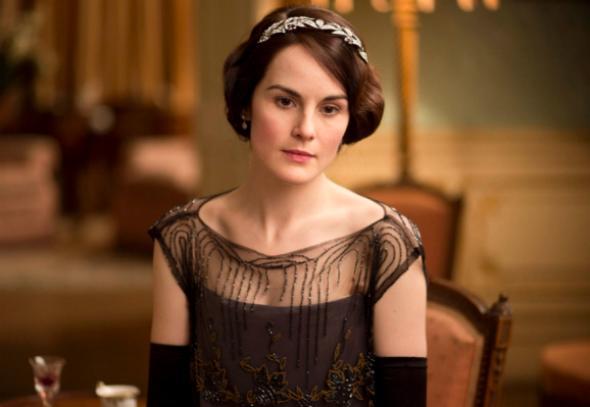Conversations about “unlikable” female characters on TV these days tend to center on Girls. But Downton Abbey’s Lady Mary Crawley, played with subtle yet delicious bite by Michelle Dockery, might be more selfish than Lena Dunham’s cupcake monster, Hannah Horvath. And she may be better proof that the qualities we look for in a friend aren’t necessarily the ones we value in a fictional character. I wouldn’t go to Mary for a shoulder to cry on, but I could listen to her passive-aggressive dinner banter all night.
The eldest of three sisters, Mary is doggedly loyal to her aristocratic family. Her surface, though, is all ice. Even when, in the third season, her baby sister Sybil dies shortly after giving birth, Mary can barely muster enough warmth to comfort Edith, the sad-sack middle child. “Oh, Mary, do you think we might get along a little better in the future?” begs Edith as they stand over their sister’s lifeless body. “I doubt it,” she bluntly replies, “but since this is the last time we three shall all be together in this life, let’s love each other now, as sisters should.”
So she’s not the most sentimental character on TV. Funny or Die was right: If Dockery played a detective, and she came upon a murdered housekeeper, she’d declare, “Well I suppose they’ll have to get another maid. Case closed.” But it’s refreshing to see a soapy program place a figure like Mary front and center. It can be a challenge to make the highborn characters on Downton Abbey appealing to a 21st-century audience—I can’t help but cringe whenever a “well-born” woman lounges with breakfast in bed, her lady’s maid hovering close by. And the show has introduced characters that act as a kind of Trojan horse for contemporary values: Dear, departed Lady Sybil once filled that role, attending rallies for women’s suffrage and training to become a nurse during the first World War.* Following her death, the show introduced fun-loving Cousin Rose, who dares invite Jack Ross, an African-American bandleader she met at a London jazz club, to perform with his band at Downton.
You’d think the show would place one of those women more aligned to our times at its center, but Mary remains Downton Abbey’s cold, cold heart. By her own admission, her husband/cousin Matthew—hey, it was the ’20s—brought out her vulnerable side. After his death by car accident at the end of the third season, Mary worries that “all the softness that he found in me seems to have dried up, drained away. Maybe it was only ever there in his imagination.” She might be onto something: Before she finds a letter from Matthew appointing her his sole heir, she feels only resentment towards her newborn son, thanks to his large share of Matthew’s inheritance. But series creator Julian Fellowes endows her with just enough sympathy for those beneath her—like her lady’s maid, Anna, and Sybil’s lowborn Irish husband, Tom—to prevent her from coming off as a complete ogre.
Still, her (literal) sense of entitlement never vanishes. In a recent episode, Mary met with Charles Blake, who is working with the government to determine whether estates like Downton are financially tenable. She’s peeved when she discovers Charles is more interested in ensuring the population is well-fed than protecting the rights of the landowners—and she unleashes her acidic tongue on the poor guy: “Don’t worry, I don’t expect Mr. Blake to be witty.”
On Downton, members of the aristocracy are often depicted as children in constant need of attention; Anna, the lady’s maid, proposes at one point that she and her husband go out for a date, saying of their employers, “We can leave when we’ve dressed them and be back in time to put them to bed.” But Mary is relatively self-sufficient. This season, she’s taken on more responsibility in the management of the abbey. She even makes scrambled eggs!
Mary has always been headstrong and proud, and—with the possible exception of Edith, who in the past two seasons has begun to resemble a modern woman—the characters on Downton Abbey don’t really change. Bates is forever the morally righteous gentleman; Mrs. Patmore, who runs the kitchen, is forever suspicious of technological advances; Edith, despite her newly chic wardrobe and frequent trips to London, has eternally bad luck. The apparent petrification of the Downton ensemble could be why so many people seem to have grown weary of the show in its fourth season. As Charles Blake—who symbolizes the changing social tides in early-20th-century England—says of Mary, “She’s the type who demands all this as a right. But she wants it on a plate. She won’t work for it and she won’t fight for it. And that type doesn’t deserve to survive.” Harsh but fair.
* Correction, Feb. 14: This post originally misstated that Lady Sybil trained to become a nurse during WWII. It was the first World War.
Previous Character Studies
Avery Barkley, Nashville
Cersei, Game of Thrones
Patty Hewes, Damages
Adam Sackler, Girls
Shirley Bennett, Community
April Ludgate, Parks and Recreation
Betty Draper, Mad Men
Sterling Archer, Archer
